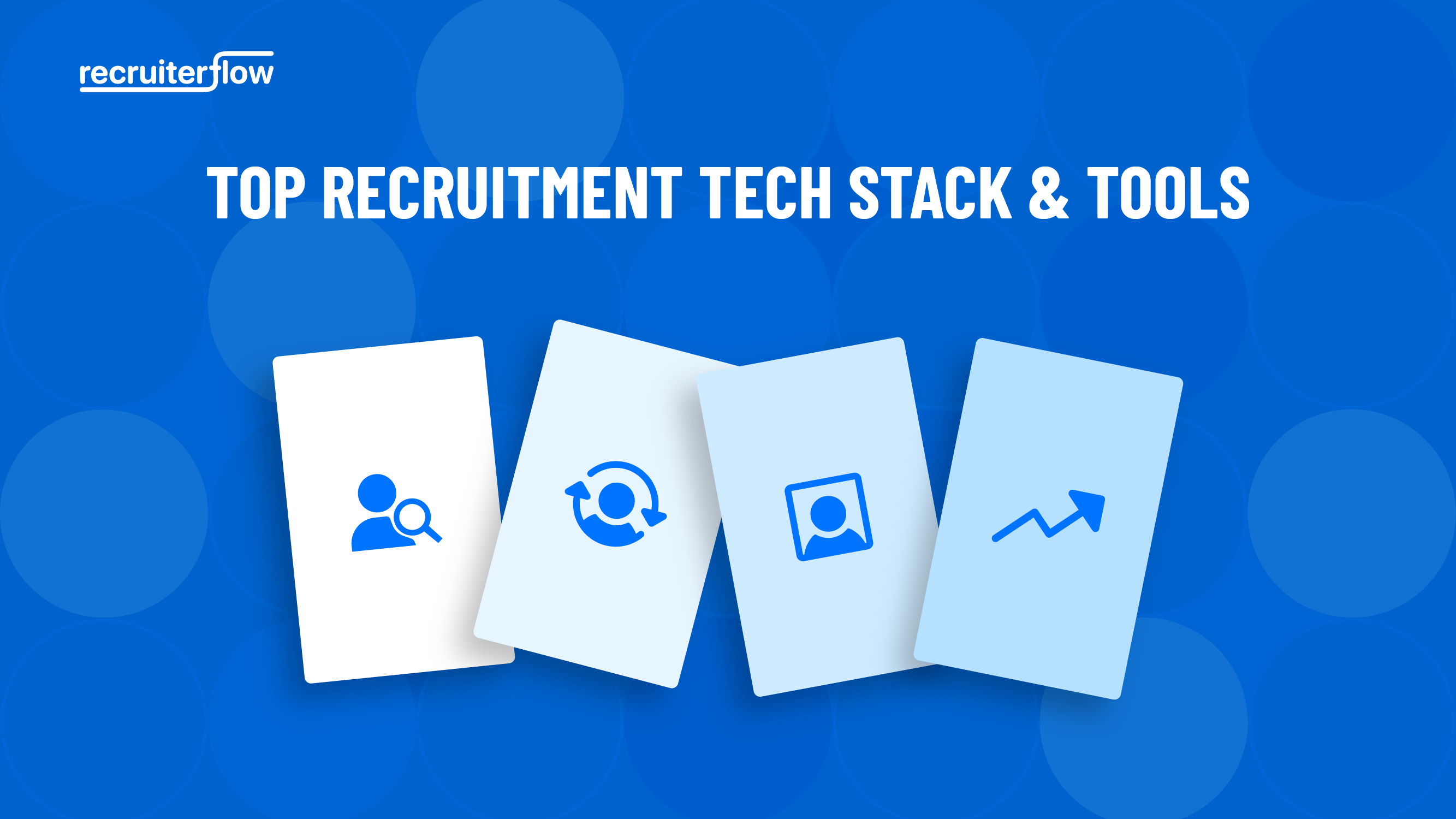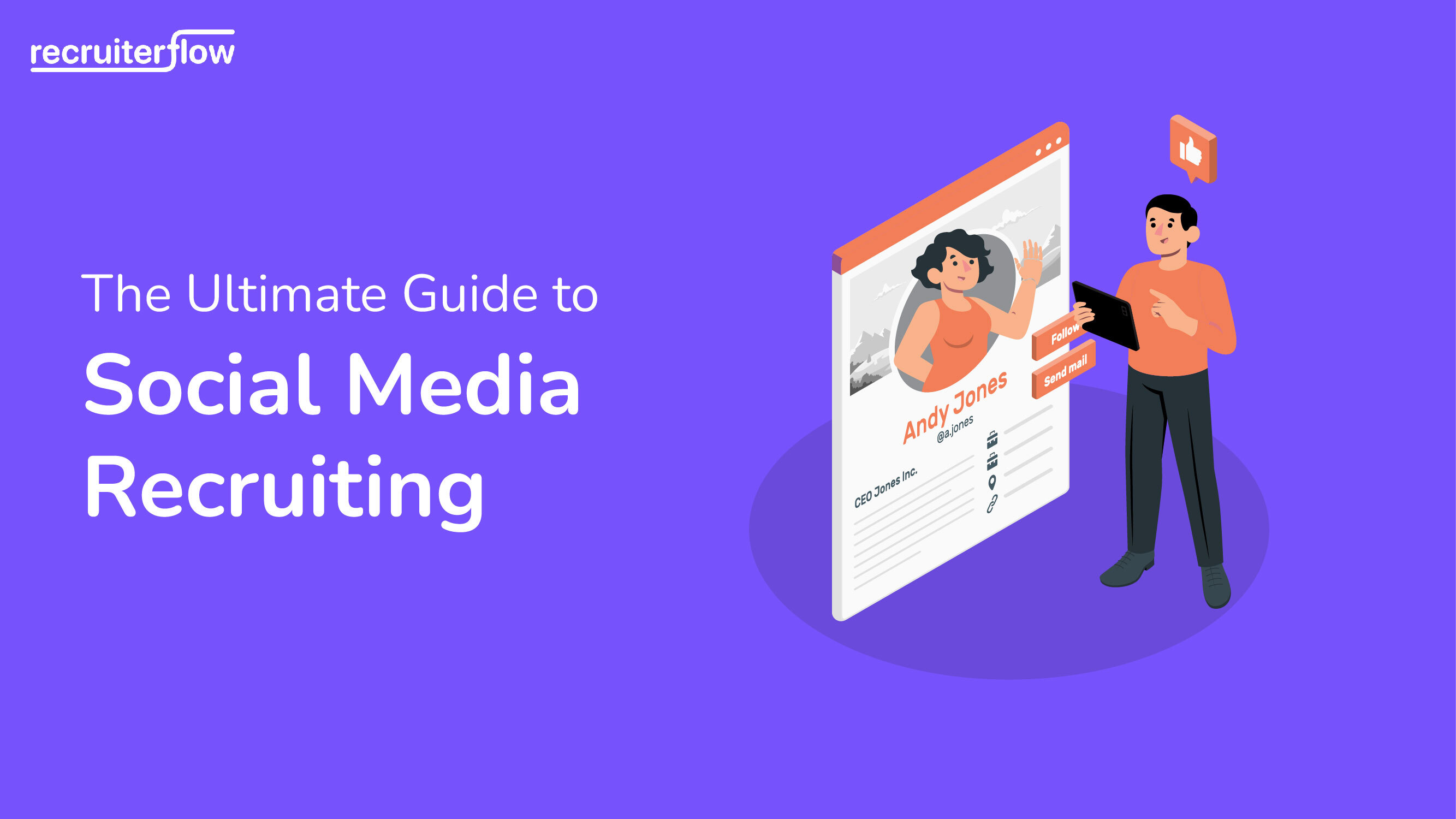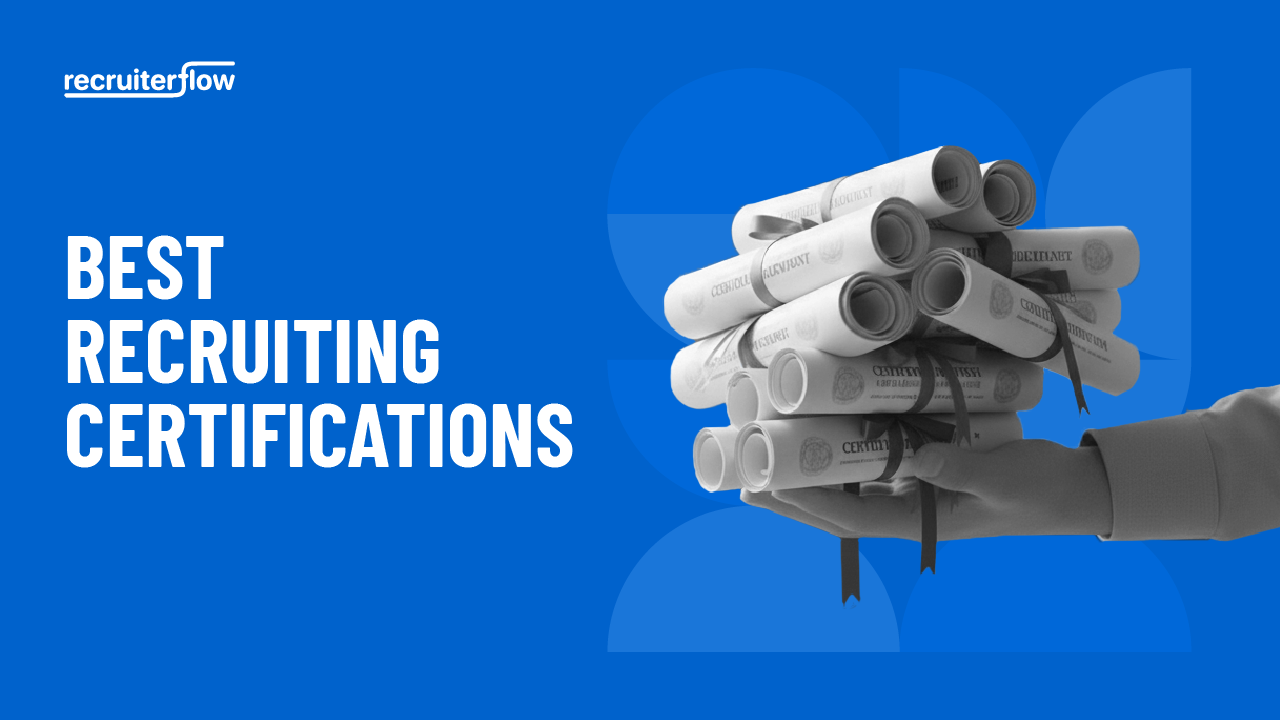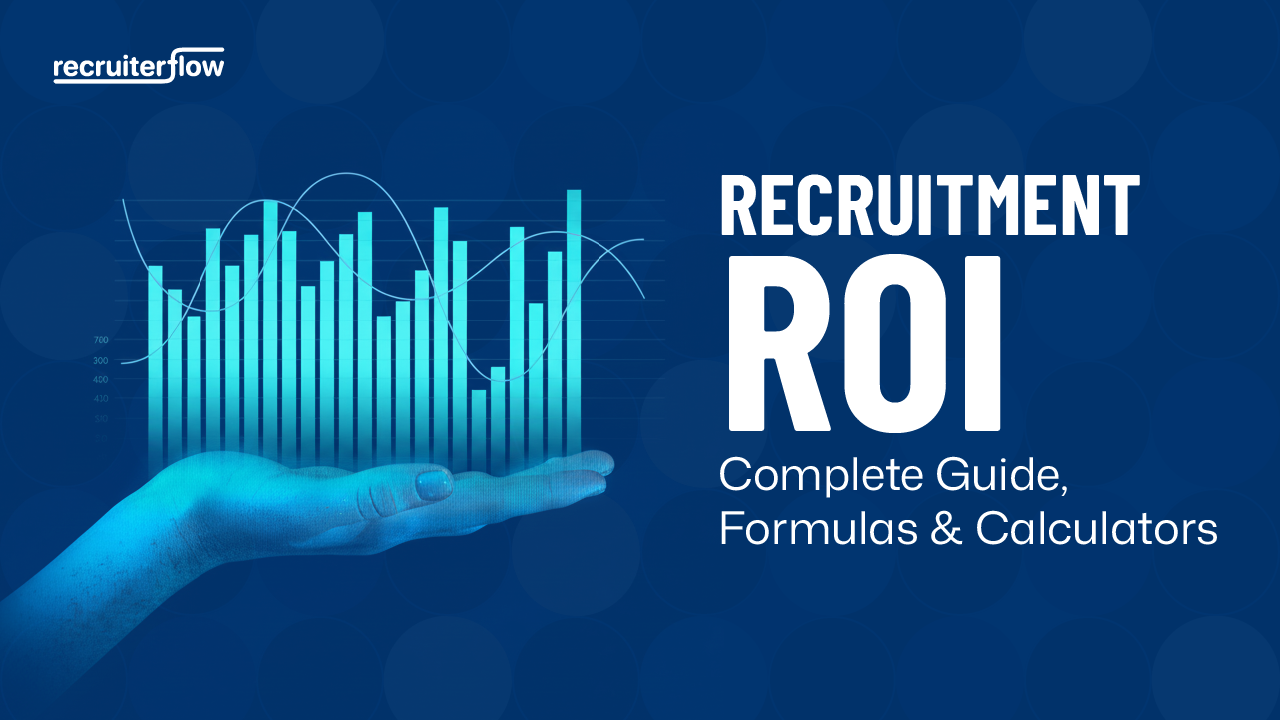
Top Recruitment Tech Stack & Tools in 2025

Recruiters in 2025 are being asked to cut cost-per-hire and raise bar-per-hire at the same time. This requires inordinate amounts of planning, collaboration and execution. Trying to accomplish this is sure to lead to busywork and burnout, unless a robust recruiting tech stack is in action.
The right recruiting platform has a lot to offer, especially with AI in the picture — a usable ATS + CRM, AI assisted sourcing and sequencing, automatic scheduling, easy assessment and background checks, clean analytics.
This article covers what a recruitment tech stack is, why it matters, a list of top recruitment tools, and guidelines on how to choose the right tool for your team.
What is a Recruitment Tech Stack?
Recruitment tech stack refers to the set of tools that drive a recruitment cycle — all the way from headcount planning, sourcing, hiring to onboarding. Think of it as a set of layers that structure and pass data between each other.
The layers include:
System of Record (ATS/CRM)
This serves as a single source of truth for requirements, candidate information, stages, offers, prospects, clients and information for long-time nurturing.
Sourcing & Market Intelligence
This layer is for identifying and qualifying talent pools. It also helps enrich profiles and map appropriate markets with regard to skills, compensation and location.
Engagement & Nurture (Sequencing / Enrichment / Campaigns)
This layer is for conducting personalized, multi-step outreach and re-engagement of promising dormant prospects. The higher goal is to scale business development for the agency in question.
Interview Ops
At this point, the tool automates coordination, manages the interview load, structures and delivers feedback. It manages scheduling, interviewer capacity and feedback turnaround.
Evaluation (Assessments & References)
This layer handles creation of predictive, role-relevant assets to minimize candidate friction. This is where assessments are created, evaluated and results declared.
Risk & Compliance
This layer deploys mechanisms to reduce hiring risk, and stay compliant with privacy, labor and equal opportunity regulations.
Insights
This layer comprises extensive analytics. It scans through layers of disparate data to find bottlenecks, predict capacity, and assert ROI.
Why Your Tech Recruiting Platform Matters
Your recruiting tech is the operating system for hiring. Recruiters need tech recruiting software to set the cadence for data cleanliness, hiring velocity and compliance.
Automates repetitive work
The right recruitment tech stack frees up recruiters from mundane, repetitive grunt work. They can focus on high-value tasks, which leads to more hires, and keeps SLAs consistent.
The tool takes over posting roles, parsing resumes, routing candidates, and chasing reminders. Recruiters can then dedicatedly pursue tailored outreach, candidate coaching, and closing top talent. Entire workflows speed up without adding to the headcount.
Also, check our blog on 4 Best Practices for Recruiting Tech Talent.
Introduces consistency into hiring flows
Many interviews, such as those for hiring in tech and senior executive layers, are complex with moving parts. To keep the process consistent and transparent, recruiters need clear stages, required fields and automatic nudges.
Technology for recruiters stabilizes the process and keeps the pipeline rolling. It prevents candidates from lingering too long in review stages. It also ensures that all stakeholders receive feedback promptly. The result is long-term predictability for agencies and fairness for candidates.
Single source of truth
Recruiters should be able to see all communication, messages, scorecards, interview results, candidate stages and notes on a single application record. Naturally, it would be linked to details around the candidate and job they are applying to.
The right tool auto-logs interactions on every touchpoint. Datasets are consolidated into one timeline with stages, sources and clear outcomes.
Outreach that scales with personalization
Appropriate recruiting technology enables personalization at scale. It offers sequences, templates and options for enrichment. Recruiters can craft messages that feel handcrafted without writing from scratch.
Tools like Recruiterflow can build multi step sequences that combine email, LinkedIn, and—where compliant—SMS or a brief voicemail. It is powered by AI agents that pull data from variables like role focus, recent milestones, and ever possible conversation openers (mutual alumni, internal referrals).
Drawing from this rich data lake helps build more precise messages that get higher open rates, more responses, more meetings booked, and attract the right kind of attention.
Real-Time Visibility
Recruiters need a live, trustworthy dashboard with immediate information on hiring operations. Recruiting tools should offer real-time visibility into hiring activity as and when it happens. Recruiters and management immediately know which candidates are advancing, which SLAs are not being met and which sources are yielding positive results that week.
Compliance and Security
Recruiting tech can also help build compliance right into the hiring process. For example, it can:
- enforce role-based access.
- mask compensation and personal identifiers from general viewers.
- setup field-level permissions to protect sensitive data.
- log all changes, maintain records for future audits.
- capture consent as part of normal workflows.
- run retention policies in the background. For instance, inactive records age out periodically, by region, with legal holds where appropriate.
Candidate Experience
Solid logistics contribute to positive candidate experiences. The right tool will ensure that :
- updates go out the moment statuses change.
- reschedules happen in a couple of clicks.
- time zones are handled gracefully.
Recruiters know from the beginning what the process looks like, how long each step typically takes, and who to contact if something slips. Candidate portals keep all relevant data in one place, so that recruiters always have full context.
In essence, recruiters have everything they need to communicate promptly, reject respectfully, explain their decisions and keep an eye out for future opportunities.
Lower Total Cost of Ownership
The right recruitment technology eliminates human effort involved in basic but necessary tasks such as downloading resumes, moving data between sheets, and resending invites. Native integrations and automation flows get rid of all grunt work, and speed up a slew of tasks that humans had to perform so far.
More automation equals fewer context switches and manual steps. As a result, hiring teams get faster cycles, clearer signals, lower rates of failed sends and follow-ups, and fewer surprises. All of this translates to serious cost savings over time.
Must Have Recruitment Technology Tools in 2025
For end to end recruitment: Recruiterflow
Recruiterflow is an AI-first ecosystem built to scale your recruitment agency. It comes equipped with an ATS and a recruitment CRM. It enables the same platform to run sourcing, outreach, pipelines, offers, and client visibility. From a single dashboard, recruiters can see and access all the data they need — notes, email threads, scorecards, and offers — to get their job done.
The tool offers in-built job posting capabilities and extensive automation configurability to remove mundane, repetitive admin work. Recruiters get Kanban views, and all stakeholders get clear times, detailed reporting, and updated logs for audit.
Recruiterflow is specifically built for teams seeking higher speed with sharper control:
- Two way email and calendar sync. Every outreach message, interview, and feedback note is automatically added to the accurate application record.
- A sequencing engine that supports personalized outreach with templates and data-backed variables.
- Job intake forms and approvals; multi board job distribution and dedicated career page generation.
- In-built job posting on 150+ job boards.
- Capabilities for interview scheduling, assessments, and background checks.
- Rule-based automation and webhooks.
- Templates for rolling out offers, including e-signatures.
- Role based permissions, field level restrictions, full audit trail, consent capture & retention policies, SSO (SAML/OIDC).
- In-depth analytics for continuous improvements and proof of ROI.
For sourcing candidates: SeekOut
SeekOut takes on keyword search and layers it with additional data. For example, recruiters can source talent by searching through open-source contributions and conference talks. Combine this with market maps, and you are likely to discover people with proven expertise.
The tool simplifies the recruiter’s journey from research to action. Staffers can use AI to define the exact scope of the ideal candidate and find profiles they might have missed. It has features for project management, clean exports, and integrations to push candidate information to the ATS.
- Enables advanced search with multiple filters — titles, skills, years, companies, GitHub/technical signals.
- In-built diversity and veteran filters.
- Ability to find profiles similar to the defined scope or specific profiles. Talent maps included.
- AI assistance to define complex “if/then” rules and find niche skill paths.
- Dashboards with talent insights (source/geography/company heatmaps) to prioritize profiles and sources.
- Market insights to narrow down the geographies and companies yielding great talent.
- Automatic enrichment of profiles with contact info.
For managing candidates: Gem
Gem connects sourcing with the ATS, enriching data, segmenting candidates, and slotting campaigns into a single view. This helps keep passive talent warm over long periods and rediscover promising but dormant accounts.
Recruiters can create target pools by defining parameters. For example, “senior backend engineers who reached onsite in the last 12 months”. Managers can view the number of candidates converting by touchpoint and by channel.
- Enables creation of unified talent pools with automatic data enrichment.
- Candidate profiles are automatically updated with fresh data.
- Enables easy creation of sequences and campaigns with in-built templates, tagging, and stop-on-reply configuration.
- Generates dynamic lists, categorized by ATS fields/tags.
- Helps rediscover forgotten applicants right for the job, based on resurfacing rules.
- Deep analytics that dissect the funnel from first contact to offer rollout.
- Two way ATS sync for stages, notes, and outreach history.
For interviewing candidates: GoodTime
GoodTime helps automate interviews without taking away human nuance. For instance, the tool creates multi-candidate panels so that recruiters don’t have to juggle different calendars and spreadsheets. They can easily find viable slots across time zones.
Recruiters can help candidates reschedule meetings and set reminders. The tool generates prep packs and nudge reminders for interviewers, so they deliver feedback promptly.
There are panel templates, availability charts, and consistent messaging. Recruiters can see if too many interviews have piled up. Managers can see if any interviewers are overloaded. Scaling is seamless, as the tool is built to handle bottlenecks and not break.
- Automatically schedules with multiple panels, using skill-based routing and timezone management.
- Enables self-scheduling and one-click reschedules by candidates.
- Automated nudges for timely feedback.
- In-depth analytics on time-to-schedule, interview utilization, and more.
For screening and assessments: HackerRank
This tool creates validated, role-based assessments to verify candidates’ fitness for individual positions. Recruiters don’t have to create tests themselves. These tests mirror actual tasks in the role rather than pointless trivia, so recruiters get a close understanding of the candidate’s abilities.
Hiring managers can review assessments within the platform, instead of dealing with multiple documents, Loom videos, recordings, etc. It makes their job easier, more consistent, and reduces admin issues.
- Offers certified role aligned assessments.
- Provides large question banks by domain.
- Plagiarism controls and session replays to preserve fairness.
- A coding environment that allows unit tests and solution playback (for tech interviews).
- Live interview mode for collaborative problem solving.
- Configurable minimum scores candidates must meet. Once they do so, they are automatically advanced to the next stage via integration with an ATS.
For making offers: Pave
Pave helps with managing negotiations around compensation. It provides recruiters and managers with living compensation bands and structures for approval.
It enhances the candidate experience by streamlining the conversation. At the same time, companies are safer because of built-in checks and guardrails.
Pave also helps companies present coherent offers, laying out base, equity, bonus, and location adjustments. Candidates can understand the complete package without too much back and forth.
Finance teams also get visibility into offers, which keeps budgets consistent across teams and geographies.
- Offers compensation bands tied to geographies, levels, roles, currency, and range.
- Comprehensive packets to visualize total compensation (cash + equity + bonus) in plain language.
- Integrations with ATS platforms so that accepted offers (and data related to them) can advance to the onboarding stage without tool or context switching.
For onboarding new hires: Rippling
Rippling breaks onboarding down into a set of coordinated, cross functional steps. Depending on the configuration, the system executes all or most of those steps for the team.
The tool nudges and helps new hires complete their paperwork with e-signatures. It helps finance manage payroll and benefits, while IT provisions devices and necessary apps. Managers can also use the platform to assign tasks for the first week.
- Role based bundles ensure the right apps and permissions are granted automatically.
- Hardware gets shipped or assigned on time.
- Compliance training is scheduled without manual chasing.
- Enables HR, IT, and managers to operate from the same record.
- Displays paperwork (I 9, tax forms) and e sign in one guided user flow.
- Manages checklists and milestone reminders; new hire task assignments.
- Inbuilt compliance training assignments.
- Audit ready logs and acknowledgements
Read More: 16 Types of Recruiting Tools to Kick off Your Hiring in 2025
Best Tech Recruiting Platforms & Software (Reviewed)
| Tool | Ideal For | G2 Rating |
| Recruiterflow | End to End Recruitment with AI-first Features | 4.7/5 |
| SeekOut | Sourcing Candidates | 4.5/5 |
| Gem | Managing Candidates | 4.8/5 |
| GoodTime | Interviewing Applicants | 4.4/5 |
| HackerRank | Screening and Assessments | 4.5/5 |
| Pave | Offer Rollout | 4.7/5 |
| Rippling | Onboarding New Hires | 4.8/5 |
How to Choose the Right Recruiting Tech Stack
When selecting tools, bear in mind that you’re building an operating system. The ideal recruiting tech stack is minimal, interconnected, and maps directly to specific business outcomes.
Consider these practical, leadership-grade parameters when choosing your tools.
Read More: Top 4 Recruiting Software Comparison for 2025
Be clear on the expected outcomes
Start by deciding what you expect out of the tool. Better time to schedule? Faster screen-to-on-site conversions? Improved offer acceptance rate? Optimized cost per hire?
Pick a few primary metrics with one corresponding guardrail. For example, reducing time to schedule by 30% without lowering onsite pass rates.
Use these to create a pilot brief, and use it to finalize every vendor conversation and configuration decision.
Study and catalog the current process and data model
Capture and record the current recruitment process followed by the team and firm. Record everything — every single candidate touchpoint, who interacts with the candidate, what communication is entailed (emails, notes, scorecards, offers), and common areas where the flow stalls.
Convert the flow into a data model covering Candidate, Application, Job/Req, Company/Client, Interview, and Offer. Standardize your taxonomies as well: stages, sources, locations, and levels.
This further clarifies the context your chosen platform must operate and thrive in, consistently at scale.
Define non negotiables early
In this domain, non-negotiable features would be:
- role based permissions
- audit trails
- consent capture
- regional data retention
- SSO (SAML/OIDC)
- SOC 2/DPA
- API/webhooks for integrations.
If any tool does not provide these capabilities, skip. Don’t be fooled by low costs; the gaps will eat into your budget within a couple of months.
Use the “1 Core + 2 Enablers” rule
Identify one system of record (ATS/CRM) as the core. Match two categories that will directly impact one or more primary metrics. For example, scheduling and sourcing for time to schedule, outreach and CRM for passive pipeline health.
Shortlist two vendors for each category. Ask for references from other recruiters or teams, if possible.
Run a pilot on real work
Run a pilot on a chosen tool (as a demo) for 21 to 30 days. Pick two active requirements. 50 candidates per team.
Feed a clean slice of data, trigger one outbound sequence, and schedule one full interview flow end-to-end.
Measure against all primary metrics. Capture all friction in shared logs.
Ask hiring managers running the demo to use structured scorecards when working with the new system.
Model ROI and TCO
Consider all seats, add ons, implementation time, and the hours to be saved with the new tool. Try this formula to calculate ROI:
ROI = (hours saved × hourly rate × 12) ÷ annual software cost.
Ask questions like:
- Will the tool enable fewer missed SLAs, fewer offer errors, and a better compliance posture?
- Will the ROI go 3× within 12 months?
If not, the scope might be too broad, or you might just need to choose another tool.
The Right Stack is Make or Break for Recruitment Teams
In 2025, recruitment teams don’t win with the biggest or most expensive stacks. They win with clean stacks that fit into their specific workflows and prioritize efficiency.
Learn More: 13 Best Recruitment Marketing Tools
A concise, tightly interconnected toolkit that enables quick user flows and trustworthy records is the silver bullet. It delivers real-time visibility, outreach at scale with appropriate personalization, consistent evaluations, and predictability. The stack should also embed governance and data hygiene into everyday protocols, and make reporting a cakewalk that needs a couple of conversations at most.
Look at the guide on how to choose a platform, and then take a demo of Recruiterflow. You’ll see that the tool fits every parameter to a T.
Let us show you how Recruiterflow can enable shorter cycle times, cleaner handoffs, and a candidate experience that leaves them talking for the right reasons.
FAQs
What is a recruiting tech stack?
The recruiting tech stack is a set of integrated tools and platforms that facilitate hiring cycles, end-to-end. It usually comprises:
- System of record (ATS + CRM)
- Sourcing and market-intelligence tools
- Outreach/nurture capabilities
- Interview operations, including scheduling and candidate intelligence
- Skills assessments
- Background checks
- Offer rollout management
- Onboarding assistance
- Analytics and governance
Recruitment tech stacks provide a single source of truth for recruiters, management, and any stakeholders, based on their role and data access clearance.
What are the top recruitment tools in 2025?
While a tool’s usability depends on the individual requirements of firms and teams, some of the most well-received recruitment tools in 2025 are:
- End-to-end recruiting for recruitment agencies: Recruiterflow
- Sourcing candidates: SeekOut
- Managing candidates: Gem
- Interviewing candidates: GoodTime
- Screening & assessments: HackerRank
- Making offers: Pave
- Onboarding new hires: Rippling
You can also read our detailed blog on recruiting tools here.
How do I choose recruiting software for my team?
Here’s a quick checklist for selecting a recruitment software solution for hiring teams:
- Start with desired outcomes, not features.
- Pick one metric to move. For example, time-to-schedule, screen-to-onsite, offer accept rate) as well as a guardrail (e.g., don’t reduce quality).
- Map a real hiring pipeline to find gaps and inefficiencies.
- Shortlist tools using the 1 Core + 2 Enablers rule.
- Run a hands-on pilot on real, live data for 21–30 days..
- Score vendors on usability, automation fit, analytics, integrations, security/governance, configurability, TCO.
- Analyze compliance (SSO, role-based permissions, audit trails, consent/retention, SOC 2/DPA).
- Migrate a clean slice of data, enforce standardized stages/sources, and observe results
- Use this model: ROI = (hours saved × hourly rate × 12) ÷ annual software cost.
- Ask vendors: Do leaders get real-time visibility without exports? Can a new recruiter complete core workflows after a day of training?






Abhishek Sharma